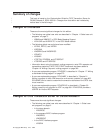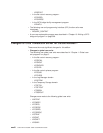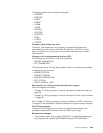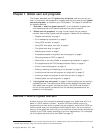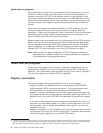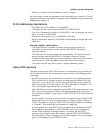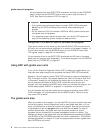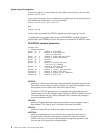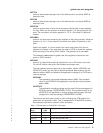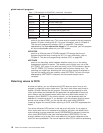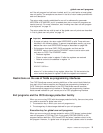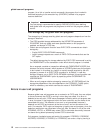v Register 15 contains the entry address of the exit program.
No other register values are guaranteed, and they should not be relied on. The exit
program should save and restore any registers that it modifies, using the save area
addressed by register 13.
31-bit addressing implications
v The global user exit is invoked in 31-bit AMODE.
v The global user exit may be either RMODE 24 or RMODE ANY.
v If you find it necessary to switch to 24-bit AMODE in the exit program, be sure to
return correctly in 31-bit AMODE.
v Ensure the exit program is in 31-bit AMODE for XPI calls.
v Some of parameters passed in DFHUEPAR are addresses of storage above the
16MB line.
Access register implications
v The global user exit is invoked in primary-space translation mode. For
information about translation modes, see the
IBM ESA/370 Principles of
Operation
manual.
v The contents of the access registers are unpredictable. For information about
access registers, see the
IBM ESA/370 Principles of Operation
manual.
v If the global user exit modifies any access registers, it must restore them before
returning control. CICS does not provide a save area for this purpose.
v The global user exit must return control in primary addressing mode.
Using CICS services
The rules governing the use of CICS services in exit programs vary, depending on
the exit point from which the exit program is being invoked. The following general
rules apply:
v No CICS services can be invoked from any exit point in the dispatcher domain.
v CICS services can be invoked using the exit programming interface (XPI) from
most exits. If you use the XPI, note the rules and restrictions that are listed for
each exit and each of the XPI macros. The XPI is described in “Chapter 3. The
user exit programming interface (XPI)” on page 283.
v Some CICS services can be requested using EXEC CICS commands from some
exits. The valid commands are listed in the detailed descriptions of the exits. If
no commands are listed, it means that no EXEC CICS API or SPI commands are
supported.
An exit program invoked at an exit that does not support the use of EXEC CICS
commands should not call a task-related user exit program (TRUE). (Calling a
TRUE is equivalent to issuing an EXEC CICS command.) TRUEs are described
in “Chapter 2. Task-related user exit programs” on page 249.
v All exit programs that issue EXEC CICS commands must first address the EIB.
This is not done automatically via the DFHEIENT macro, as is the case with
normal EXEC assembler-language programs. Therefore, the first EXEC
command to be issued from an exit program must be EXEC CICS ADDRESS
EIB (eib-register), where “eib-register” is the default register (R11) or the register
given as a parameter to the DFHEIENT macro.
global user exit programs
Chapter 1. Global user exit programs 5
|
|
|
|



